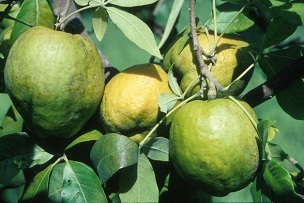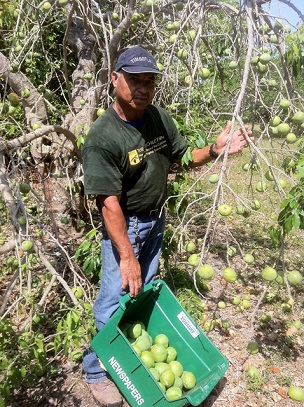From Fairchild
Tropical Botanic Garden
by Noris Ledesma Curator of Tropical Fruit
White Sapote: Unique and Delicious
As published in the Miami Herald
White sapote (Casimiroa edulis)
is a relative of citrus and sometimes called "Custard Apple" because of
the texture of the flesh. Though, it is not the same as the fruit of
that actual name. Nor is White Sapote actually related to other fruit
called Sapote. Originally introduced from central Mexico and is well
adapted to South Florida.

Fruit
can be shaped similar to a green apple with a smooth skin; it can be
green, yellow, or orange in color. The smooth textured pulp, is
pleasantly flavored like banana with peach and some people say
reminiscent of caramel, and custard apple flavor. The fruit is highly
nutritious, being rich in vitamins A and C. I particularly I like
to eat it with a spoon, its gorgeous golden fruit flesh being as soft
and delicate as any mousse. Some of the people I ask for uses of this
fruit express that it is anything better than the white sapote ice
cream.
It makes a beautiful medium-sized spreading evergreen
tree and a good addition to any South Florida landscape. Good
Floridian selections are available in local nurseries. A good grafted
tree can start bearing in three to four years. The harvest season
varies with variety but generally is during the spring and summer, ans
some even extend the season through November. Although the white sapote
can be easily grown from seed, it is not recommended. The fruit
from a seedling is almost always inferior to that of a named, grafted
variety.

White sapote trees at Fairchild full of fruit,
more often times break branches with their weight.
The
white sapote prefers well draining soils, but will tolerate almost any
type of soil. Fertilization is best done with three applications per
year (March, July, and September), with 8-3-9 or other fruit tree
formulation. Annual pruning will produce trees at a manageable
height and provide ready access to the fruit. As the branches elongate,
some pruning is done to induce lateral growth. Many white sapote trees
have received little or no care and yet have been long-lived.
Mature
and all ready established trees are quite drought-resistant; they have
been known to thrive in vacant lots, however, water the tree on a
regular basis during dry season. A mature white sapote tree also will
tolerate more cold than an avocado tree.
Sapotes can be eaten
alone or combined with other fresh fruits in salads. It can be used for
jellies, sherbets, ice creams, pies, or drying, or eating out of hand.
White sapote can vary in color from dark green to bright yellow at
maturity. Color is an important measure to determine the optimum time
to harvest. When the fruit is ripe enough to eat, the stem will fall
off or come off very easily. If the fruit is allowed to over ripen, it
can become unpleasant quickly.
Keep them in room
temperature. Don’t pile them up as they get soft when ripe and are
highly susceptible to bruising. Before eating, remove the skin which
has a bitter flavor, overripe fruit also becomes bitter. Some cultivars
have a slight amount of bitterness in the flesh, particularly near the
skin.
They are usually picked a few weeks before they would be
fully ripe. Most of the time, they will develop quite a good flavor
when left to ripen off the tree. Not every cultivar's fruit,
though, will, - one variety such as Pike doesn't develop its flavor
well when picked so early. They are often shipped not fully ripe.
The
white sapote are the model of efficiency for the modern homeowner.
There will be a maximum amount of time to enjoy the fruit of one’s
labors and a minimum of work in managing the tree. It may take a little
more time to find a good selection, but the reward is indeed
substantial. Find one, plant it and enjoy!
Back to
White Sapote Page
|
|

